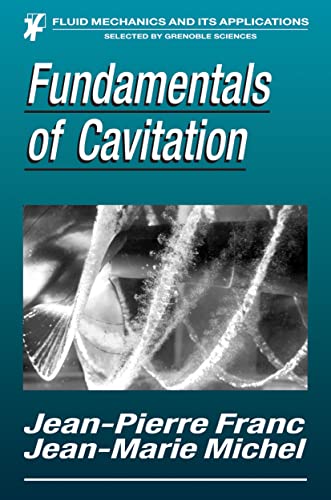Articoli correlati a Fundamentals Of Cavitation: 76

Sinossi
This book treats cavitation, which is a unique phenomenon in the field of hyd- dynamics, although it can occur in any hydraulic machinery such as pumps, propellers, artificial hearts, and so forth. Cavitation is generated not only in water, but also in any kind of fluid, such as liquid hydrogen. The generation of cavitation can cause severe damage in hydraulic machinery. Therefore, the prevention of cavitation is an important concern for designers of hydraulic machinery. On the contrary, there is great potential to utilize cavitation in various important applications, such as environmental protection. There have been several books published on cavitation, including one by the same authors. This book differs from those previous ones, in that it is both more physical and more theoretical. Any theoretical explanation of the cavitation phenomenon is rather difficult, but the authors have succeeded in explaining it very well, and a reader can follow the equations easily. It is an advantage in reading this book to have some understanding of the physics of cavitation. Therefore, this book is not an introductory text, but a book for more advanced study. However, this does not mean that this book is too difficult for a beginner, because it explains the cavitation phenomenon using many figures. Therefore, even a beginner on cavitation can read and can understand what cavitation is. If the student studies through this book (with patience), he or she can become an expert on the physics of cavitation.
Le informazioni nella sezione "Riassunto" possono far riferimento a edizioni diverse di questo titolo.
Contenuti
-Foreword; Hiroharu Kato. -Preface. Symbols. -1: Introduction - The main features of cavitating flows. 1.1. The physical phenomenon. 1.2. Cavitation in real liquid flows. 1.3. Specific features of cavitating flow. 1.4. Non-dimensional parameters. 1.5. Some historical aspects. -2: Nuclei and cavitation. 2.1. Introduction. 2.2. Equilibrium of a nucleus. 2.3. Heat and mass diffusion. 2.4. Nucleus population. References. -3: The dynamics of spherical bubbles. 3.1. Basic equations. 3.2. The collapse of a vapor bubble. 3.3. The explosion of a nucleus. 3.4. The effect of viscosity. 3.5. Non-linear oscillations of a bubble. 3.6. Scaling considerations. 3.7. Stability of a spherical interface. References. -4: Bubbles in a non-symmetrical environment. 4.1. Introduction. 4.2. Motion of a spherical bubble in a liquid at rest. 4.3. Non-spherical bubble evolution. 4.4. The path of a spherical bubble. References. Appendix to Section 4.3.3. -5: Further insights into bubble physics. 5.1. The effect of compressibility. 5.2. Bubble noise. 5.3. Some thermal aspects. 5.4. A typical numerical solution. References. Appendix to Section 5.1.3. -6: Supercavitation. 6.1. Physical aspects of supercavities. 6.2. Supercavity flow modeling using steady potential flow theory. 6.3. Typical results. 6.4. Axisymmetric cavities. 6.5. Specific problems. References. Appendix: singular behavior at detachment. -7: Partial cavities. 7.1. Partial cavities on two-dimensional foils. 7.2. Partial cavities in internal flows. 7.3. The cloud cavitation instability. 7.4. Wakes of partial cavities. 7.5. Thermal effects in partial cavitation. References. Appendix: sonic velocity in a liquid/vapor mixture with phase change. -8: Bubbles and cavities on two-dimensional foils. 8.1. Attached cavitation. 8.2. Traveling bubble cavitation. 8.3. Interaction between bubbles and cavities. 8.4. Roughness and cavitation inception. References. -9: Ventilated supercavities. 9.1. Two-dimensional ventilated supercavities. 9.2. Axisymmetric ventilated supercavities. 9.3. Analysis of pulsating ventilated supercavities. References. -10: Vortex cavitation. 10.1. Theoretical results. 10.2. The non-cavitating tip vortex. 10.3. Cavitation in a tip vortex. References. -11: Shear cavitation. 11.1. Jet cavitation. 11.2. Wake cavitation. References. -12: Cavitation erosion. 12.1. Empirical methods. 12.2. Some global results. 12.3. Basic hydrodynamic mechanisms of energy concentration. 12.4. Aggressiveness of a cavitating flow. 12.5. Insight into the material response. References. Index.
Le informazioni nella sezione "Su questo libro" possono far riferimento a edizioni diverse di questo titolo.
EUR 4,68 per la spedizione in U.S.A.
Destinazione, tempi e costiCompra nuovo
Visualizza questo articoloGRATIS per la spedizione in U.S.A.
Destinazione, tempi e costiRisultati della ricerca per Fundamentals Of Cavitation: 76
Fundamentals Of Cavitation
Da: Basi6 International, Irving, TX, U.S.A.
Condizione: Brand New. New. US edition. Expediting shipping for all USA and Europe orders excluding PO Box. Excellent Customer Service. Codice articolo ABEOCT25-153603
Quantità: 1 disponibili
Fundamentals of Cavitation (Fluid Mechanics and Its Applications, 76)
Da: ALLBOOKS1, Direk, SA, Australia
Brand new book. Fast ship. Please provide full street address as we are not able to ship to P O box address. Codice articolo SHAK153603
Quantità: 1 disponibili
Fundamentals of Cavitation (Fluid Mechanics and Its Applications (76))
Da: Lowry's Books, Three Rivers, MI, U.S.A.
Hard Cover. Condizione: Very Good. No Jacket. Very good condition. Size: 8vo - over 7¾" - 9¾" tall. Codice articolo 119634
Quantità: 1 disponibili
Fundamentals of Cavitation
Da: Books Puddle, New York, NY, U.S.A.
Condizione: New. pp. 332. Codice articolo 26319603
Quantità: 1 disponibili
Fundamentals of Cavitation
Da: Majestic Books, Hounslow, Regno Unito
Condizione: New. pp. 332 Illus. Codice articolo 7561132
Quantità: 1 disponibili
Fundamentals of Cavitation
Da: Biblios, Frankfurt am main, HESSE, Germania
Condizione: New. pp. 332. Codice articolo 18319609
Quantità: 1 disponibili
Fundamentals of Cavitation (Fluid Mechanics and Its Applications, 76)
Da: BennettBooksLtd, San Diego, NV, U.S.A.
Hardcover. Condizione: New. In shrink wrap. Looks like an interesting title! Codice articolo Q-1402022328
Quantità: 1 disponibili
Fundamentals of Cavitation (Fluid Mechanics and Its Applications, 76)
Da: Best Price, Torrance, CA, U.S.A.
Condizione: New. SUPER FAST SHIPPING. Codice articolo 9781402022326
Quantità: 2 disponibili
Fundamentals Of Cavitation
Da: GreatBookPrices, Columbia, MD, U.S.A.
Condizione: New. Codice articolo 3492334-n
Quantità: Più di 20 disponibili
Fundamentals of Cavitation (Fluid Mechanics and Its Applications, 76)
Da: Lucky's Textbooks, Dallas, TX, U.S.A.
Condizione: New. Codice articolo ABLIING23Mar2411530142324
Quantità: Più di 20 disponibili

